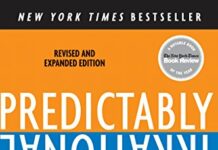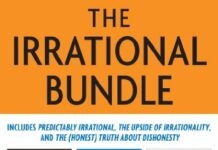
Ebook Info
- Published: 2012
- Number of pages: 350 pages
- Format: PDF
- File Size: 1.42 MB
- Authors: Dan Ariely
Description
“Top-notch science writing covering everything from the 1,000 species in the human gut to efforts to reverse-evolve a chicken into a dinosaur.” —Kirkus Reviews With contributions from bestselling and award-winning writers including Jerome Groopman and Elizabeth Kolbert, this volume delves into such topics as the 2008 “Black Friday” stampede at a Long Island Walmart; an annual humans-vs.-AI competition; octopus intelligence; lab-grown meat; marauder ants; the brains of teenagers; and the Neanderthal genome. Lively and accessible, this is “a showcase for clean, plain-English science and nature writing and a treat for readers” (Kirkus Reviews). “This strong collection invites awe, begets wonder, and stimulates contemplation.” —Publishers Weekly “There is so much we don’t know, which leads us to make so many irrational decisions that we need scientists and science writers to share their inquiries and discoveries in welcoming and lucid prose. Stellar examples of just this sort of cogent and compelling writing sustains this invaluable and exciting series.” —Booklist Contributors include: Brendan Buhler · Virginia Hughes • Jerome Groopman • Carl Zimmer • Thomas Hayden • Michael Behar • Bijal P. Trivedi • Sy Montgomery • Mark W. Moffett • Deborah Blum • Elizabeth Kolbert • Michael Roberts • Thomas Goetz • Jason Daley • David Dobbs • David Eagleman • John Seabrook • David Kirby • Robert Kunzig • Michael Specter • Mark McClusky • Rivka Galchen • Joshua Davis • Brian Christian
User’s Reviews
Reviews from Amazon users which were colected at the time this book was published on the website:
⭐Science is my favorite adult Wonderland, and The Best American Science and Nature Writing of 2012 brings me, and others like me, the keys to my favorite kingdom.Reading this series is an annual ritual for me. There have been times when other annual rituals have let me down, including Christmas, New Year’s, Thanksgiving, and my birthday. But reading The Best American Science and Nature series never has, and for similar reasons year after year.Reason number one, the least important reason, but nonetheless justification in and of itself for my ritual, is that the 25 or so articles serve as a broadly informative “catch up” to what’s hot in the various fields of science. As they love to say in the business world, one should be on the bleeding edge of one’s fields of interest, and this series, including the 2012 version, keeps one right in that vicinity.Reason number two: sheer and unadulterated delight. Science, well done, and well explained, is an exhilarating and heady (no pun intended!) place for the brain to hang out. The stories in this book range from ants that fight ground wars with a sophistication that rivals anything the Pentagon can come up with, to an article that opens up with the statement “You are not you”, and then goes on to explain the ramifications of the fact that only 10% of the cells that compose your body are your own, the other 90% are bacteria that are along for far more than just a ride: you cannot be well without their presence. Which leads to reason number three.Reason number three to read this book, and it’s my favorite reason, is that you cannot read it, put it down, and look on the world around you in the same way you did before you picked it up. Criminal justice, crowds that panic with fatal results, the gaze of an octopus in an aquarium, and the very air you breathe: your perception of each is dramatically, and permanently, altered by what you read in these marvelous articles. Put the book on your nightstand, read one story each night….for a fortnight or two, you’ll face each new day with an altered perspective. Which is an incredible bargain even if this book cost ten times what it actually does.
⭐I read this book together with a small group of actively retired seniors conducting a discussion group on science and social science topics. We are a group of 16 retired engineers, doctors, researchers, professors, teachers, nurses, etc. who band together once a week for two hours to discuss topics of interest. With this book, we’d read and discuss two essays a week. Members would come to our casual discussions, having read and thought about the essays, perhaps done a bit of background research to further expand the topics, and one member would prepare a list of questions to get the discussion going.”The Best American Science and Nature Writing 2012″ proved to be an ideal platform from which to launch an enjoyable group discussion. The essays were carefully selected and represent a good cross-section of the best American science and nature writing over the 2012 calendar year. No one complained that any essay was too difficult or too boring. Most of us were reading outside our field of expertise, but found the essays easy to read and excellent platforms from which to launch further research (generally on the Internet). Members would bring this further research to the group to share.If I have one problem with this series, it is what becomes lost by transferring these essays from typically glossy magazine format to simple black-and-white printed anthology format. What is often lost are the photographs, charts, graphs, and scientific illustrations that accompanied the original article. Much of this visual material is extremely helpful. Some is essential. In the case of our group, we all read the article in the book, and then typically one member or another would find the original article either in the library or through the Internet and make a copy to pass around the class. If there were an easily available Internet version, that link for the article would be sent to other members via email before our group discussion. Thus each member would get a chance to see the original visual material that may have accompanied the original article before our group discussion. Naturally, if this anthology included colored images the price would be too high, so we were not unhappy with this compromise and managed as individuals and as a group to work around it well.I believe I would join each and every member of our group in recommending this anthology highly.
⭐I have enjoyed this series for years. It features a guest editor, a prominent science writer or scientist who writes for the lay reader. The guest editor picks his or her favorite science articles from publications for the general reader, under the direction of the series editor, Tim Folger. It normally includes a very broad selection of topics in science and nature.This year Dan Ariely broke with tradition and organized his selections according to a theme. Not surprisingly for a psychologist, Ariely’s theme is the human condition, explorations that in his mind help enlighten what makes us human. The topics range from the microbes that inhabit the human body to the ways ants make war to the Loebner Prize competition in which competitors vie to see if they fool human judges into thinking that a computer is actually a human. I found that the selections do, indeed, exemplify Ariely’s theme; he has done a good job.In many ways this approach makes for a more interesting read as a book, but it also makes me feel I’ve not received what I have come to expect. As a result of Ariely’s thematic approach, the selection is much narrower than usual and includes almost no physical science. It made me wonder what articles really deserved inclusion among the “best of the year” but just did not fit the theme. Folger lists some “Runners up” at the end of the book, which I may feel more compelled to follow up than I normally would. I will also be more interested in its “competitor” series , The Best American Science Writing, which I had stopped reading because, for some odd reason, it is not available in electronic format.Highly recommended, but don’t be disappointed if you have read and enjoyed this series in the past and do not find what you expected.
⭐Very good !
⭐As always, broadens the mind.
⭐The book is great, lucid for people not used to academic writing. However the book appears to be used or old.
⭐Love the entire series – the best summaries of excellent and relevant scientific topics. Snippets of fascinating activity into the wondrous world of science and nature!
⭐Scientific American, National Geographic, WeirdやThe New Yorkerなどに掲載されたサイエンスライターの記事を集めた本です。内容は英検1級のリーディング問題の科学系記事が楽しいと思える人なら満足できると思います。もちろん、記事の長さはリーディング問題よりは3倍以上長いものが中心です。ミクロの生物のはなしから、環境の話まで取り扱っています。各記事の著者はNew York Timesなどの科学記事でも見かけるフリーランスのライターたちですね。今回のゲストエディターは行動経済学や心理学のベストセラー本でも知られてるDan Arielyですが、過去にはE.O.Wilson, R.Dawkins, S. Pinker, F.DysonやB. Greeneなどの学者であり著名なポピュラーサイエンスのベストセラー本を出してる人たちがゲストエディターをしているシリーズのようです。ながさはポピュラーサイエンスのペーパーバックに比べれば短い記事が25本ほどあるので長いのは躊躇するという人にもおすすめできると思う。専門用語に難しく感じる場合はあるかもしれません。The Best Americanシリーズはこれ以外にもいろんな分野のものが発売されてるけど、似たようなものなのかもしれません。
⭐
Keywords
Free Download The Best American Science and Nature Writing 2012 (The Best American Series) in PDF format
The Best American Science and Nature Writing 2012 (The Best American Series) PDF Free Download
Download The Best American Science and Nature Writing 2012 (The Best American Series) 2012 PDF Free
The Best American Science and Nature Writing 2012 (The Best American Series) 2012 PDF Free Download
Download The Best American Science and Nature Writing 2012 (The Best American Series) PDF
Free Download Ebook The Best American Science and Nature Writing 2012 (The Best American Series)




